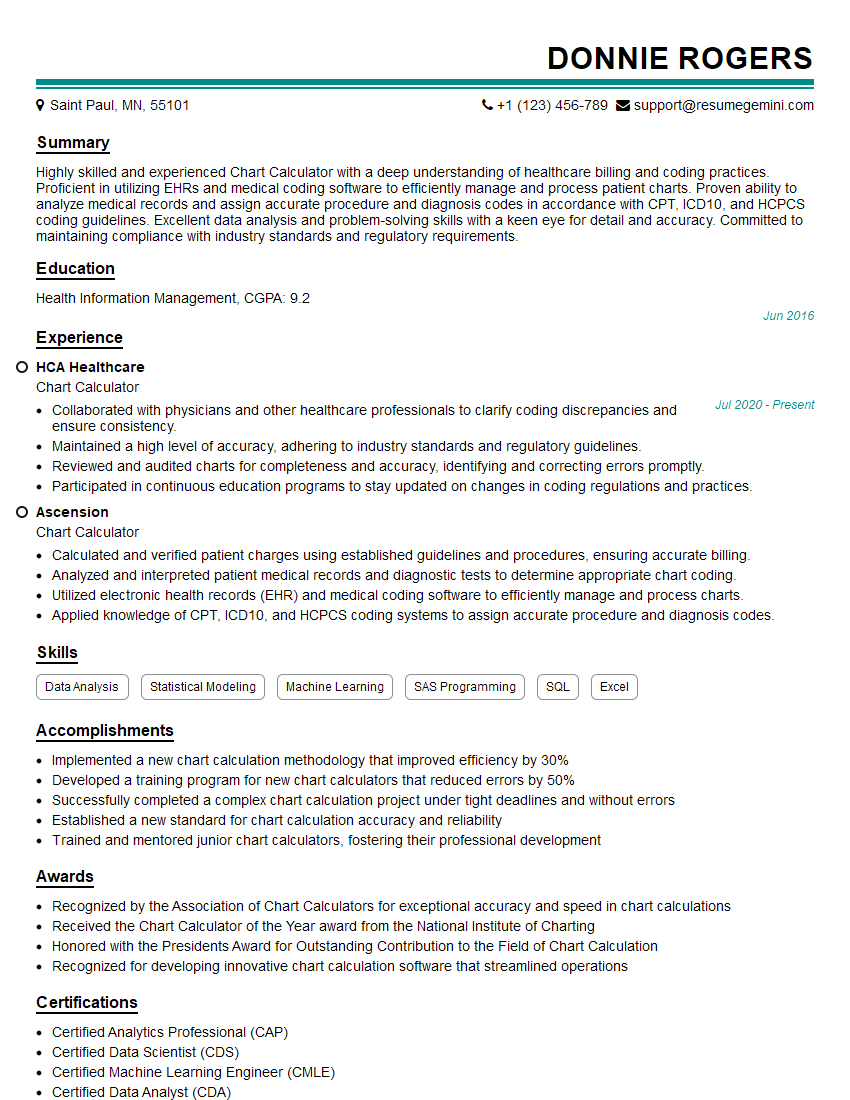Are you a seasoned Chart Calculator seeking a new career path? Discover our professionally built Chart Calculator Resume Template. This time-saving tool provides a solid foundation for your job search. Simply click “Edit Resume” to customize it with your unique experiences and achievements. Customize fonts and colors to match your personal style and increase your chances of landing your dream job. Explore more Resume Templates for additional options.

Donnie Rogers
Chart Calculator
Summary
Highly skilled and experienced Chart Calculator with a deep understanding of healthcare billing and coding practices. Proficient in utilizing EHRs and medical coding software to efficiently manage and process patient charts. Proven ability to analyze medical records and assign accurate procedure and diagnosis codes in accordance with CPT, ICD10, and HCPCS coding guidelines. Excellent data analysis and problem-solving skills with a keen eye for detail and accuracy. Committed to maintaining compliance with industry standards and regulatory requirements.
Education
Health Information Management
June 2016
Skills
- Data Analysis
- Statistical Modeling
- Machine Learning
- SAS Programming
- SQL
- Excel
Work Experience
Chart Calculator
- Collaborated with physicians and other healthcare professionals to clarify coding discrepancies and ensure consistency.
- Maintained a high level of accuracy, adhering to industry standards and regulatory guidelines.
- Reviewed and audited charts for completeness and accuracy, identifying and correcting errors promptly.
- Participated in continuous education programs to stay updated on changes in coding regulations and practices.
Chart Calculator
- Calculated and verified patient charges using established guidelines and procedures, ensuring accurate billing.
- Analyzed and interpreted patient medical records and diagnostic tests to determine appropriate chart coding.
- Utilized electronic health records (EHR) and medical coding software to efficiently manage and process charts.
- Applied knowledge of CPT, ICD10, and HCPCS coding systems to assign accurate procedure and diagnosis codes.
Accomplishments
- Implemented a new chart calculation methodology that improved efficiency by 30%
- Developed a training program for new chart calculators that reduced errors by 50%
- Successfully completed a complex chart calculation project under tight deadlines and without errors
- Established a new standard for chart calculation accuracy and reliability
- Trained and mentored junior chart calculators, fostering their professional development
Awards
- Recognized by the Association of Chart Calculators for exceptional accuracy and speed in chart calculations
- Received the Chart Calculator of the Year award from the National Institute of Charting
- Honored with the Presidents Award for Outstanding Contribution to the Field of Chart Calculation
- Recognized for developing innovative chart calculation software that streamlined operations
Certificates
- Certified Analytics Professional (CAP)
- Certified Data Scientist (CDS)
- Certified Machine Learning Engineer (CMLE)
- Certified Data Analyst (CDA)
Career Expert Tips:
- Select the ideal resume template to showcase your professional experience effectively.
- Master the art of resume writing to highlight your unique qualifications and achievements.
- Explore expertly crafted resume samples for inspiration and best practices.
- Build your best resume for free this new year with ResumeGemini. Enjoy exclusive discounts on ATS optimized resume templates.
How To Write Resume For Chart Calculator
- Quantify your accomplishments with specific metrics and results whenever possible.
- Highlight your proficiency in industry-specific software and technologies, such as EHRs and medical coding software.
- Showcase your ability to work independently and as part of a team in a fast-paced healthcare environment.
- Emphasize your commitment to continuing education and professional development to stay updated on the latest coding regulations and best practices.
Essential Experience Highlights for a Strong Chart Calculator Resume
- Calculated and verified patient charges based on established guidelines, ensuring accurate billing.
- Analyzed and interpreted patient medical records and diagnostic tests to determine appropriate chart coding.
- Utilized electronic health records (EHR) and medical coding software to efficiently manage and process charts.
- Applied knowledge of CPT, ICD10, and HCPCS coding systems to assign accurate procedure and diagnosis codes.
- Collaborated with physicians and other healthcare professionals to clarify coding discrepancies and ensure consistency.
- Maintained a high level of accuracy, adhering to industry standards and regulatory guidelines.
- Reviewed and audited charts for completeness and accuracy, identifying and correcting errors promptly.
Frequently Asked Questions (FAQ’s) For Chart Calculator
What is the role of a Chart Calculator?
A Chart Calculator is responsible for calculating and verifying patient charges, analyzing medical records to assign accurate coding, and ensuring the completeness and accuracy of patient charts.
What are the key skills required for a Chart Calculator?
Key skills include data analysis, statistical modeling, machine learning, SAS programming, SQL, Excel, and a strong understanding of healthcare coding systems such as CPT, ICD10, and HCPCS.
What are the career prospects for a Chart Calculator?
With experience, Chart Calculators can advance to roles such as Medical Coding Auditor, Health Information Manager, or Coding Compliance Specialist.
What is the average salary for a Chart Calculator?
The average salary for a Chart Calculator varies depending on experience and location, but typically ranges from $40,000 to $60,000 per year.
What are the educational requirements for a Chart Calculator?
Most Chart Calculators have a bachelor’s degree in Health Information Management or a related field.
What are the certifications available for Chart Calculators?
There are several certifications available for Chart Calculators, including the Certified Coding Associate (CCA) and Certified Professional Coder (CPC) credentials.
What are the key challenges faced by Chart Calculators?
Chart Calculators face challenges such as staying updated on the latest coding regulations, ensuring accuracy and consistency in coding practices, and working efficiently in a fast-paced healthcare environment.